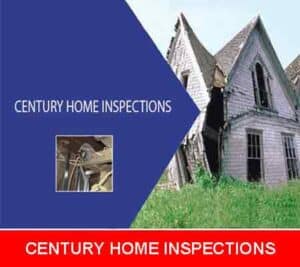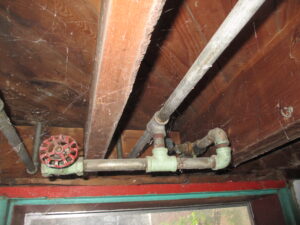Inspecting Century Homes
Inspecting century homes can be a fascinating endeavor, as these properties often come with unique features, historical significance, and potential challenges. Whether you’re a homeowner, potential buyer, or simply interested in historical architecture, here are some key aspects to consider when inspecting century homes:Most buyers want the assurance of a qualified home inspector before buying, what could be in some cases, a potential “Money Pit”. Usually just the age of the building is a testimony to the quality of construction, but there are some items that need to be verified prior to committing your hard earned dollars.
historical architecture, here are some key aspects to consider when inspecting century homes:Most buyers want the assurance of a qualified home inspector before buying, what could be in some cases, a potential “Money Pit”. Usually just the age of the building is a testimony to the quality of construction, but there are some items that need to be verified prior to committing your hard earned dollars.
Items to Consider Prior to Buying
- Historical Significance: Research the history of the home and the surrounding area. Determine if the home has any historical significance or is part of a historic district. This information can provide valuable context for understanding the property.
- Structural Integrity: Check for signs of structural issues, such as foundation cracks, sagging floors, and uneven walls. Century homes might have experienced settling over the years, so a thorough inspection by a structural engineer might be necessary.
- Foundation and Basement: Examine the foundation for cracks, water damage, and signs of moisture. Basements in older homes might have unique features like stone walls and exposed beams, but they can also be susceptible to dampness. The grade of the foundation is extremely important to the condition of framing members and perimeter framing etc.Having a foundation wall that is too low to grade level is just inviting moisture and water to attack your structural framing members and subsequent rotting.
- Crawl Spaces: Most crawl spaces are usually wet or damp, which can adversely affect the condition of the wood supporting the structure.Testing all the support and framing structure in the crawl space will quickly determine the condition of the wood.
- Roof and Attic: Inspect the roof for leaks, missing or damaged shingles, and signs of aging. Century homes might have different roofing materials than modern homes. Also, check the attic for proper insulation and ventilation. Many older homes have had insulatioin topped up with Vermicultie Insulation. Many types of vermiculite have asbestos traces which will typically require removement.
- Exterior: Look for signs of decay, rot, and deterioration on the exterior, including siding, trim, and windows. Historic homes might have unique architectural features that require specialized maintenance and restoration.
- Plumbing and Electrical Systems: Assess the plumbing and electrical systems for outdated components. Century homes might still have knob-and-tube wiring or old plumbing materials that need upgrading to meet
 modern safety standards. Some century homes have a combination of older wire and newer Romex with ground. Replacing older two wire on exterior walls can be a very expensive project. Many homes in the 50’s had galvanized plumbing installed. The life expectancy of galvanized plumbing is typically 50 years. Many insurance companies will not insure a home with galvanized plumbing.
modern safety standards. Some century homes have a combination of older wire and newer Romex with ground. Replacing older two wire on exterior walls can be a very expensive project. Many homes in the 50’s had galvanized plumbing installed. The life expectancy of galvanized plumbing is typically 50 years. Many insurance companies will not insure a home with galvanized plumbing. - Heating and Cooling: Evaluate the heating and cooling systems. Century homes might have original fireplaces, radiators, or other historic heating methods that need to be inspected for safety and functionality. Older century homes may not have any heating ducts supplying 2nd floor. Some older homes just have large cast iron gravity vents cut into floors.
- Insulation and Energy Efficiency: Consider the insulation and energy efficiency of the home. Older homes might lack proper insulation, leading to higher energy costs. Explore options for improving insulation without compromising the historical integrity of the property.
- Mold and Lead Paint: Be aware of the potential for mold and lead paint in older homes. Address these issues promptly to ensure the health and safety of occupants.
- Interior Features: Look for original architectural features like ornate moldings, hardwood floors, decorative plasterwork, and unique built-ins. These elements can add charm and character to century homes.
- Restoration vs. Renovation: Decide whether you want to restore the home to its original historical appearance or update it with modern amenities. Striking a balance between preservation and functionality is crucial. Most century homes have been renovated mulitple times over the years. Ensuring that all the work was done to appropriate Building Code Requirements can be a labourous process.
- Local Regulations: Familiarize yourself with local historic preservation regulations and zoning codes that might affect what you can do with the property. Certain changes or renovations might require approval from historic preservation boards.
- Cost of Maintenance: Understand that maintaining a century home can be more expensive than maintaining a newer home due to the need for specialized repairs and materials. Intricate trim mouldings that were common when home was built may no longer be available and might require custom fabrication.
- Professional Inspection: Engage a qualified home inspector with experience in century homes. Additionally, consider consulting with specialists such as historical preservation experts, structural engineers, and contractors who are familiar with older properties. The Orillia Home Inspector has inspected hundreds of Century Homes and has written many articles on the knowledge required to properly inspect them.
Orillia Home Inspector Methods
We start our inspection as soon as we pull up to your property. We visually start inspecting the house and grounds looking for any problems or areas of concern. We typically start by climbing your roof and inspecting shingles, flashing, windows, trim, sills, caulking and plumbing vents. Many times we find Ice & Water shield missing which is required by code for all newer buildings. We continue our exterior inspection on the ground and encompass the landscaping, drainage and exterior of the home. On the interior we start in the basement and work our way through the house up to the attic. All defect pictures and deficiencies are included in a easy to read computerized report.
flashing, windows, trim, sills, caulking and plumbing vents. Many times we find Ice & Water shield missing which is required by code for all newer buildings. We continue our exterior inspection on the ground and encompass the landscaping, drainage and exterior of the home. On the interior we start in the basement and work our way through the house up to the attic. All defect pictures and deficiencies are included in a easy to read computerized report.
Read More about the Orillia Home Inspector’s Methods.

